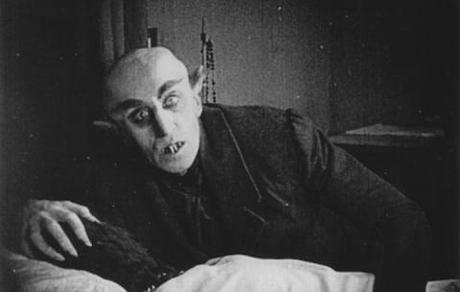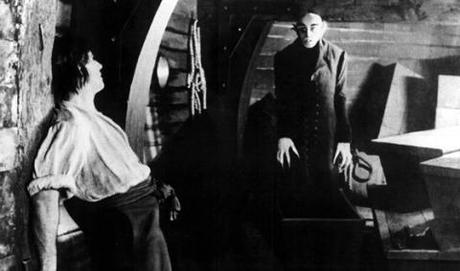
by Steve Habrat
There was a time when audiences feared the vampire. He wasn’t viewed as a sex symbol, a glittery pretty boy who pined after a pasty high school girl, drove a sports car like Vin Diesel, and (I shudder to even write this) went out in sunlight. No, there was a time when the vampire was a monster, a creature that leapt from the shadows of our nightmares and hovered over us while we slept in the dead of night. He was a representation of plague, disease, and unholy death, a dusty, bat-like spawn of Satan that rested his pale skin in a coffin lined with the soil from the Black Plague. This was even before Bela Lugosi’s cock-eyed Count, a gentleman who politely told his prey, “I vant to suck yer blahood,” while reaching a contorted hand out from the lid of his coffin. Many regard Universal’s 1931 gothic horror film Dracula as the original and definitive vampire film. Anytime someone mentions the name Dracula, the face that comes to mind is Lugosi’s curled smile, widow’s peak, and bulging eyes. While Lugosi may be the poster boy for “scary” and “serious” vampires, perhaps the most terrifying vampire of all is Max Shreck’s Count Orlok, the pointy-eared demon who stalked the mortals of F.W. Murnau’s 1922 German Expressionist masterpiece Nosferatu. Alive with a creeping supernatural atmosphere that slowly closes around the viewer, menacing shadow play, and a performance that reigns supreme over all other movie monsters, Murnau’s Nosferatu stands as the greatest interpretation of Bram Stoker’s Dracula.
Real estate agent Thomas Hutter (played by Gustav von Wangenheim) is sent by his boss, Knock (played by Alexander Grannach), to Transylvania to meet with Count Orlok (played by Max Shreck), who has recently purchased a home in the town of Wisborg. Saddened to leave his new wife, Ellen (played by Greta Schroeder), Hutter sets out on a lengthy trip into the country where he meets skittish locals, who all warn of “Nosferatu,” the undead that prowl the woods around Orlok’s castle. Ignoring their warnings, Hutter continues his trip to the castle, but as they get closer, Hutter’s carriage driver gets spooked and refuses to go any further. It doesn’t take long for another carriage to meet Hutter and he is ushered to the front door of the seemingly abandoned castle. Shortly after his arrival, Hutter meets with Count Orlok, a seemingly friendly enough individual who invites Hutter to sit down to a hot meal. As the hours pass within the darkened walls of the castle, Hutter begins to suspect that there may be supernatural forces at play. Meanwhile, Orlok has plans of his own for both Hutter and the new town that is expecting him.
Renamed due to not being able to obtain the rights to Stoker’s novel, Nosferatu is perhaps the most down-to-earth vampire film ever made. There are no undead bloodsuckers morphing into bats or wolves, just a misshapen ghoul with pointy ears and elongated fingers that wanders the empty halls of a dilapidated castle. Vampirism itself is presented as more of an apocalyptic plague rather than a satanic spell, as “plague” rats scatter in the diseased wake of Count Orlok. Every now and then, Murnau suggests that there are unseen supernatural forces at play, especially when Hutter nears Orlok’s secluded dwelling. At first, Murnau just shows animals scurrying about the brush and we get a few shots of what is supposedly a werewolf prowling around looking for prey. Once Hutter is picked up by Orlok’s phantom carriage, a handful of images are presented in the negative, almost like Murnau is ripping the shroud of normalcy off the film itself and showing the supernatural underbelly of the ordinary. He does this again later in film, when he shows us a close up of a spider stalking a tangled insect in its web, a symbolic reference to the spidery Orlok and his helpless prey unable to pull themselves out of his hypnotic web. As far as Orlok goes, the most fantastic aspect about him outside of his striking appearance is how he suddenly appears in front of people, manifesting almost of out thin air.

Then we have Shreck’s hypnotic and measured performance as the dreaded Count Orlok, a monstrous role that could be one of the most iconic in the history of horror. Shreck fills every single movement with malevolence, each rigid twitch of his finger or tilt of his head suggests a very long and hellish life as one of the undead. His fingers curl around like the legs of a spider, at one point jutting out from his waist as he skulks into Hutter’s room for a bloody treat. His ears resemble the ears of a bat and his eyes bulge out of his head, appearing to lack a pupil when viewed through the grainy black and white camera work. Then there are his fangs, which resemble the teeth of a rat as they jut out and hang over his lips. Muranu even compares his physical appearance to that of a Venus flytrap, which he does in a left-field lecture about the plant. There is nothing particularly gentlemanly about him as he hangs in a window and stares out of Ellen, whom he desperately wishes to have his way with. The two share a mesmerizing moment and they are not even in the same shot. Orlok closes in on a sleeping Hutter while Ellen, who is miles away, sees Orlok closing in on her dearly beloved in her nightmare.
While Shreck is actually more of a supporting player rather than top billing, he overshadows every other performer in Nosferatu. Gustav von Wangenheim overacts a bit as Hutter, but you suppose that he has to because he doesn’t have sound to fall back on. He’s the hero of the picture, one that falls victim early on in Orlok’s mansion of madness, but he tries his hardest to prevent the undead evil from spreading his plague. Greta Schroeder’s Ellen possesses a dark side as she suffers from horrific nightmares that cause her to wander the railing of her balcony. Alexander Grannach gets nuts as Knock, Hutter’s employer who snickers with glee over the arrival of his “master.” He has black circles around his eyes and he has a ring of frizzy hair that suggests that he has spent a night or two in the local loony bin. John Gottowt is also present as Professor Bulwer, the man who is basically responsible for pointing out the similarities between Count Orlok and the Venus flytrap.
While the lack of sound may turn many viewers away, those who stick with Nosferatu are in for a terrifying treat. There are a number of sequences that are iconic, especially the sequence aboard a ship that finds Count Orlok slowly picking off the sailors one by one. The sequence culminates in an image that is one of the most blood-curdling moments in horror history. Orlok’s stiff body bursts from a cracked coffin and reveals itself in all its bony glory, only to then make his way to the top deck and stalk the captain. Another sequence that rewards is the final moments of the film, with Orlok locked onto the neck of one of the main characters as the sun slowly shatters the night sky. If the repulsive Orlok doesn’t make you quiver, the seemingly abandoned gothic landscape will certainly make you tense. Atmosphere and architecture become major players in the film, especially the jagged, fang-like homes that comprise the Wiborg skyline and peer into Ellen’s bedroom like jaws waiting to bite into her flesh. Overall, as one of the original monster movies, Nosferatu is a surreal and haunting gothic horror film. The images that Murnau frames are guaranteed to stick with you the rest of your life and Shreck’s performance alone will give you a renewed fear of the dark. Nosferatu will forever remain that greatest and scariest vampire movie ever made.
Grade: A+
Nosferatu is available on DVD.
